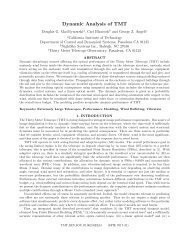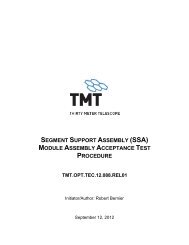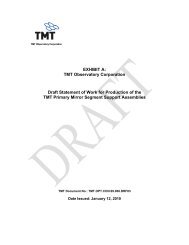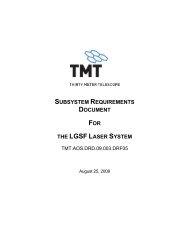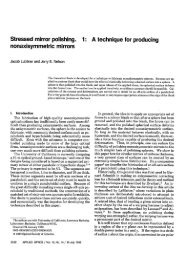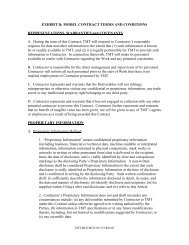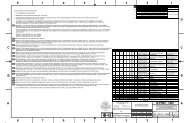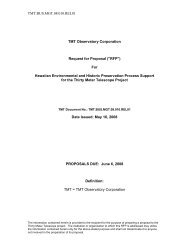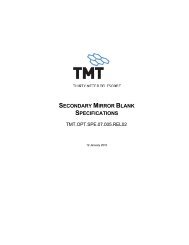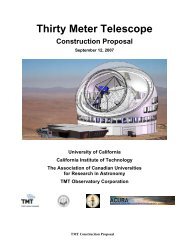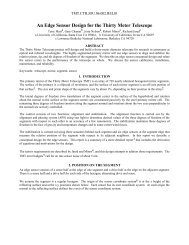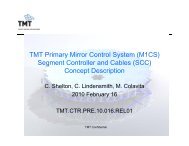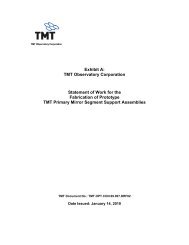Advancement of the Segment Support System - Thirty Meter Telescope
Advancement of the Segment Support System - Thirty Meter Telescope
Advancement of the Segment Support System - Thirty Meter Telescope
Create successful ePaper yourself
Turn your PDF publications into a flip-book with our unique Google optimized e-Paper software.
Warping harness<br />
leaf-spring, typ.<br />
<strong>Segment</strong> Position<br />
Actuator<br />
Actuator flexure<br />
Tower Assembly with<br />
Repeatable Interface<br />
Figure 4<br />
Mirror Cell<br />
Fixed Frame<br />
The Polished Mirror Assembly (left) mounts to fixed frame and actuators which are supported by<br />
<strong>the</strong> mirror cell (right). The Polished Mirror Assembly is removed from <strong>the</strong> telescope for recoating<br />
<strong>of</strong> <strong>the</strong> optical surface.<br />
3. PERFORMANCE PREDICTIONS<br />
The performance <strong>of</strong> <strong>the</strong> telescope is strongly influenced by <strong>the</strong> performance <strong>of</strong> <strong>the</strong> SSA subjected to varying gravity and<br />
temperature fields. These effects are considered in <strong>the</strong> design and analysis <strong>of</strong> <strong>the</strong> SSA, and in some cases trade<strong>of</strong>fs <strong>of</strong><br />
one performance characteristic against ano<strong>the</strong>r are required. For example, it is possible to minimize <strong>the</strong> <strong>the</strong>rmal<br />
distortion response <strong>of</strong> <strong>the</strong> segment at <strong>the</strong> expense <strong>of</strong> <strong>the</strong> lateral gravity performance. The character <strong>of</strong> <strong>the</strong> surface errors<br />
is also an important factor in assessing <strong>the</strong> relative merit <strong>of</strong> a particular design. For example, low spatial frequency<br />
errors are more easily tolerated because <strong>the</strong>y impact <strong>the</strong> seeing-limited performance to a lesser degree than high<br />
frequency errors <strong>of</strong> <strong>the</strong> same RMS magnitude. Similarly, <strong>the</strong> telescope Adaptive Optics system has <strong>the</strong> ability to<br />
compensate for low spatial frequency errors, but not for higher frequency errors. Thermal distortion errors typically<br />
contain a significant component <strong>of</strong> focus which is better tolerated than higher frequency errors from axial or lateral<br />
gravity print-through.<br />
TMT intends to final-figure and acceptance-test segments after <strong>the</strong>y are attached to <strong>the</strong>ir support systems, with <strong>the</strong><br />
segments zenith-pointing, and at <strong>the</strong> mean observing temperature. By figuring in this manner, <strong>the</strong> distortion due to axial<br />
gravity and assembly pre-stresses can be removed, along with a significant portion <strong>of</strong> <strong>the</strong> <strong>the</strong>rmal distortion. Therefore,<br />
all performance predictions are relative to <strong>the</strong> final-figured condition. This also implies that <strong>the</strong> axial surface error<br />
springs back as <strong>the</strong> segment is inclined from <strong>the</strong> local zenith (ζ SSA =0) as [1-cos(ζ SSA )], with <strong>the</strong> lateral print-through<br />
increasing from zero at <strong>the</strong> zenith in proportion to [sin(ζ SSA )]. Thermal distortion is proportional to <strong>the</strong> temperature<br />
difference between <strong>the</strong> acceptance test temperature and <strong>the</strong> segment temperature during observing.<br />
3.1 <strong>System</strong>-level Finite Element Simulations<br />
A system-level finite element model, Figure 5, was developed to provide an integrated approach to assessing <strong>the</strong> optical<br />
performance, strength, and stability <strong>of</strong> <strong>the</strong> SSA. The system model, developed using FEMAP [10] and solved using NX-<br />
NASTRAN [11] , captures <strong>the</strong> following important effects which improve <strong>the</strong> quality <strong>of</strong> predictions:<br />
• Combined interaction <strong>of</strong> <strong>the</strong> axial and lateral support systems<br />
• Compliance <strong>of</strong> <strong>the</strong> many structural components, important for optical and dynamic performance predictions



